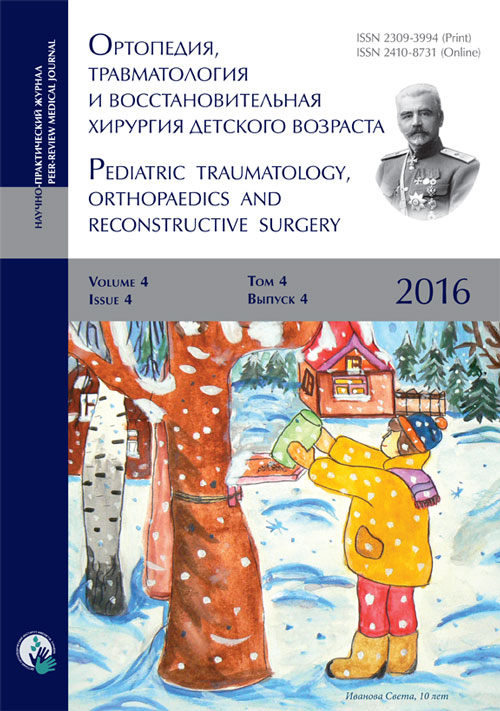Нейросегментарный уровень и его значение при лечении подвывиха и вывиха бедра у детей с последствиями спинномозговых грыж
- Авторы: Баиндурашвили А.Г.1, Иванов С.В.1, Кенис В.М.1
-
Учреждения:
- ФГБУ «НИДОИ им. Г.И. Турнера» Минздрава России
- Выпуск: Том 4, № 4 (2016)
- Страницы: 6-11
- Раздел: Статьи
- URL: https://bakhtiniada.ru/turner/article/view/5889
- DOI: https://doi.org/10.17816/PTORS446-11
- ID: 5889
Цитировать
Аннотация
Актуальность. Патология тазобедренного сустава у детей с последствиями спинномозговых грыж является частым сопутствующим состоянием и в подавляющем большинстве случаев сопровождается формированием подвывиха и вывиха бедра.
Цель исследования — определение влияния нейросегментарного уровня на результаты хирургического лечения подвывиха и вывиха бедра у детей с последствиями спинномозговых грыж.
Материалы и методы. В ФГБУ «НИДОИ им. Г.И. Турнера» Минздрава России в период с 2006 по 2015 год проведено обследование и лечение 114 пациентов с подвывихом и вывихом бедра с последствиями спинномозговых грыж. Основная группа представлена 62 пациентами, которые получили хирургическое лечение, направленное на стабилизацию тазобедренного сустава. Контрольная группа — 52 ребенка, которые хирургического лечения по поводу подвывиха и вывиха бедра не получили. Внутри каждой группы пациенты распределены на две подгруппы в зависимости от нейросегментарного уровня поражения спинного мозга, используя методику Sharrаrd.
Результаты. У пациентов основной группы с высокими нейросегментарными уровнями (грудной и L1-L2) хирургическое лечение подвывиха и вывиха бедра в большинстве случаев (16 из 22, то есть 72 %) привело к ухудшению двигательного уровня (архивный материал); у пациентов с нейросегментарными уровнями L3-L4 и L5-S1 в 13 из 40 случаев (32,5 %) двигательный уровень улучшился, в то время как у пациентов контрольной группы двигательные возможности ухудшились в 10 из 28 (36 %) случаев.
Заключение. Определение нейросегментарного уровня позволяет прогнозировать двигательный
Ключевые слова
Полный текст
Открыть статью на сайте журналаОб авторах
Алексей Георгиевич Баиндурашвили
ФГБУ «НИДОИ им. Г.И. Турнера» Минздрава России
Автор, ответственный за переписку.
Email: turner01@mail.ru
д-р мед. наук, профессор, академик РАН, заслуженный врач РФ, директор ФГБУ «НИДОИ им. Г.И. Турнера» Минздрава России Россия
Станислав Вячеславович Иванов
ФГБУ «НИДОИ им. Г.И. Турнера» Минздрава России
Email: turner01@mail.ru
канд. мед. наук, научный сотрудник отделения патологии стопы, нейроортопедии и системных заболеваний Россия
Владимир Маркович Кенис
ФГБУ «НИДОИ им. Г.И. Турнера» Минздрава России
Email: kenis@mail.ru
д-р мед. наук, заместитель директора по развитию и внешним связям, руководитель отделения патологии стопы, нейроортопедии и системных заболеваний Россия
Список литературы
- Asher M, Olson J. Factors affecting the ambulatory status of patients with spina bifida cysticа. J Bone Joint Surg Am. 1983;65(3):350-6.
- Correll J, Gabler C. The effect of soft tissue release of the hips on walking in myelomeningocele. J Pediatr Orthop B. 2000;9(3):148-153. doi: 10.1097/01202412-200006000-00003.
- Feiwell E, Sakai D, Blatt A. The effect of hip reduction on function in patients with myelomeningocele. Potential gains and hazards of surgical treatment. J Bone Joint Surg Am. 1978;60(2):169-73.
- Erol B, Bezer M, Kucukdarmaz F, et al. Surgical management of hip instabilities in children with spina bifida. Acta Orthop Traumatol Turc. 2005;39(1):16-22.
- Баиндурашвили А.Г., Иванов С.В., Кенис В.М. Подвывих и вывих бедра у детей с последствиями спинномозговых грыж (обзор литературы) // Травматология и ортопедия России. – 2013. – № 4. – С. 97–102. [Baindurashvili AG, Ivanov SV, Kenis VM. Subluxation and dislocation of the hip in children with spina bifida (Review). Traumatology and Orthopedics of Russia. 2013;(4):97-192. (In Russ.)]
- Бадалян Л.О. Невропатология. – М.: Просвещение, 1987. – 316 с. [Badalyan LO. Nevropatologiya. Moscow: Prosvechenie; 1987. 316 p. (In Russ.)]
- Иванов С.В., Кенис В.М., Икоева Г.А., и др. Использование роботизированной двигательной реабилитации в комплексном лечении подвывиха и вывиха бедра у детей с последствиями спинномозговой грыжи // Ортопедия, травматология и восстановительная хирургия детского возраста. – 2014. – Т. II. – Вып. 4. – С. 32–35. [Ivanov SV, Kenis VM, Ikoeva GA, et al. The use of robotic rehabilitation in complex treatment of subluxation and dislocation of the hip in children with sequelae of spina bifida. Pediatric Traumatology, Orthopaedics and Reconstructive Surgery. 2014;2(4):32-5. (In Russ.)]
- Thomson JD, Segal LS. Orthopedic managment of spina bifida. Dev Disabill Res Rev. 2010;16(1):96-103. doi: 10.1002/ddrr.97.
- Yildirim T, Gursu S, Bayhan İA, et al. Surgical treatment of hip instability in patients with lower lumbar level myelomeningocele: Is muscle transfer required? Clin Orthop Relat Res. 2015;473(10):3254-60. doi: 10.1007/s11999-015-4316-8.
- Sharrard WJW. The segmental innervation of the lower limb muscles in man. Ann R Coll Surg Engl. 1964;35:106-22.
Дополнительные файлы







